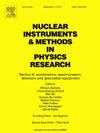尾流场加速度研究用w波段波纹波导的实验设计
IF 1.5
3区 物理与天体物理
Q3 INSTRUMENTS & INSTRUMENTATION
Nuclear Instruments & Methods in Physics Research Section A-accelerators Spectrometers Detectors and Associated Equipment
Pub Date : 2025-04-25
DOI:10.1016/j.nima.2025.170549
引用次数: 0
摘要
由于其紧凑的尺寸和高梯度的潜力,次太赫兹(sub-THz)频段的射频(RF)结构在结构尾流场加速方面的应用备受关注。我们提出了110 GHz金属波纹波导的设计、制造和实验装置,优化了阿贡韦克菲尔德加速器(AWA) 42 MeV电子束参数。利用AWA的发射度交换(EEX)光束线对两种情况进行纵向束形:(1)长约250μm的单个驱动电子束经历高减速梯度;(2)采用由三角形驱动串和长见证串组成的双串串组成的高变压器比探测尾流场。初步实验结果,数据分析正在进行中。本文章由计算机程序翻译,如有差异,请以英文原文为准。
Experimental design of a W-band corrugated waveguide for wakefield acceleration studies
Radiofrequency (RF) structures in the sub-terahertz (sub-THz) regime are of interest for applications in structure wakefield acceleration due to their compact size and potential for high gradients. We present the design, fabrication, and experimental setup of a metallic corrugated waveguide at 110 GHz, optimized for the 42 MeV electron beam parameters at the Argonne Wakefield Accelerator (AWA). The emittance exchange (EEX) beamline at AWA was used to perform longitudinal bunch shaping for two cases: (1) a high decelerating gradient experienced by a single drive electron bunch about long; (2) a high transformer ratio using a two-bunch train consisting of a triangularly shaped drive bunch followed by a long witness bunch to probe the wakefield. Preliminary experimental results are presented, and data analysis is ongoing.
求助全文
通过发布文献求助,成功后即可免费获取论文全文。
去求助
来源期刊
CiteScore
3.20
自引率
21.40%
发文量
787
审稿时长
1 months
期刊介绍:
Section A of Nuclear Instruments and Methods in Physics Research publishes papers on design, manufacturing and performance of scientific instruments with an emphasis on large scale facilities. This includes the development of particle accelerators, ion sources, beam transport systems and target arrangements as well as the use of secondary phenomena such as synchrotron radiation and free electron lasers. It also includes all types of instrumentation for the detection and spectrometry of radiations from high energy processes and nuclear decays, as well as instrumentation for experiments at nuclear reactors. Specialized electronics for nuclear and other types of spectrometry as well as computerization of measurements and control systems in this area also find their place in the A section.
Theoretical as well as experimental papers are accepted.

 求助内容:
求助内容: 应助结果提醒方式:
应助结果提醒方式:


